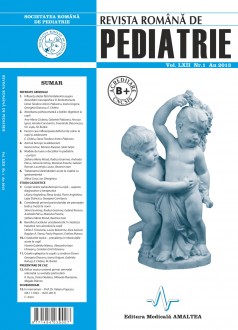SELECT ISSUE

Indexed

| |

|
|
|
| |
|
|
|

|
|
|
|
|
|
|
HIGHLIGHTS
National Awards “Science and Research”
NEW! RJP has announced the annually National Award for "Science and Research" for the best scientific articles published throughout the year in the official journal.
Read the Recommendations for the Conduct, Reporting, Editing, and Publication of Scholarly work in Medical Journals.
The published medical research literature is a global public good. Medical journal editors have a social responsibility to promote global health by publishing, whenever possible, research that furthers health worldwide.
Ursodeoxycholic acid benefi t in pediatric non-alcoholic fatty liver disease
Otilia E. Frăsinariu, Laura Bozomitu, Alice Azoicăi, Bogdan A. Stana, Paula Popovici and Evelina Moraru
REZUMAT
Introduction. Nonalcoholic fatty liver disease (NAFLD), the most common cause of chronic liver disease in children, encompasses a range of disease from simple steatosis to steatohepatitis (NASH). Ursodeoxycholic acid (UDCA) has been used in adult pacients with NASH, demonstrating its efficacy in high doses.
Purpose. The aim of our study was to assess the effect of high-dose ursodeoxycholic acid therapy on liver functions in children with NASH.
Methods. We prospectively studied 18 children with NASH aged 2.5 to 17 years. NASH was operationally defined as diffusely hyperechogenic liver at ultrasonography with persistently elevated (> 35 UI/l) alanine aminotransferase (ALT) or aspartate aminotransferaze (AST) after exclusion of viral, alcohol-induced, druginduced, cholestatic and genetic causes of liver disease. Patients were treated with ursodeoxycolic acid (20 mg/ kg per day) for six month.
Results. Treatment with UDCA significantly decreased hepatic transaminases. ALT levels ranged from 68.5 (50-166) at baseline vs. 47 (29-104) after six month, p <0.001, AST from 43 (29-101) 34 (17-75), p < 0.001, and GGT between 41.5 (11-150) vs. 22 (8-55). At the end of treatment, ALT levels normalized in 4 patients. Moreover, cholesterol levels were significantly reduced after treatment.
Conclusions. Treatment with high-dose ursodeoxycholic acid improves liver function parameters in children with NASH.
Cuvinte cheie: steatoză hepatică, acid ursodeoxicolic, transaminaze hepatice
